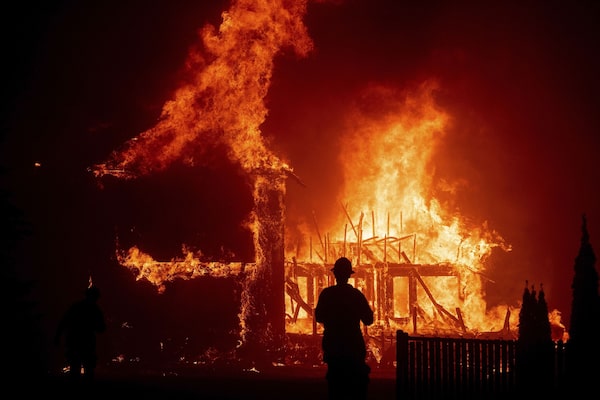
A home burns as the Camp Fire rages through Paradise, Calif., on Nov. 8, 2018.Noah Berger/The Associated Press
Every year, millions of people are forced to leave their homes due to a variety of climate or natural disasters, ranging from floods – one-third of Pakistan was inundated last summer – to droughts and topical storms.
The term “climate refugee” has entered the environmental lexicon and the Institute for Economics and Peace (IEP) has said there could be 1.2 billion such refugees by 2050 as the planet turns into a frying pan. The number is a guess, but perhaps not a wild one. The UN High Commissioner for Refugees says that an annual average of 21.5 million people have been displaced by extreme weather events since 2008, though it’s an open question whether global warming specifically can take the blame.
Typically, we consider climate-induced movements – “disaster displacement” or “cross-border disaster displacement,” to use the technical terms – to be a southern hemisphere phenomenon, especially in the poorest countries that cannot afford climate mitigation and adaptation programs. But the weather is changing everywhere and we are seeing the start of climate-related exoduses not just to North America but within it.
Oakland, on the east side of San Francisco Bay, in California, is a case in point. The city sent a small delegation to COP27 in Egypt and considers itself at the forefront of the continental climate crisis.
Daniel Hamilton, the city’s sustainability and resilience officer – an ever more serious job as California heats up and gets whacked by climate disasters – said in an interview at COP27 that climate is at least partly responsible for the net exodus from his city. “We are seeing more people leaving Oakland than coming in,” he said. “We think that climate is influencing their departures and that is what we are hearing, especially from people with health issues like asthma.”
Precise data on Oakland’s climate-related exodus are not available, since climate can be one of several reasons to hit the road. Job opportunities, work-life balance, cheaper housing and the better ability to work remotely are among the factors that push families out of big, crowded, expensive cities.
But more and more reports, studies and media interviews with those leaving Oakland and other Californian cities suggest that climate is playing a bigger role than ever in the decision to flee. A 2021 survey by the academic journal Climatic Change found that 57 per cent of American respondents said that “weather or climate-related issues” would influence their decision to move in the next decade.
In America, the urge to flee appears especially acute in California, which alone in 2020, during a record heat wave, had 8,000 wildfires, a few of them deadly. The infamous 2018 Camp wildfire in Butte County, about 250 kilometres north of Oakland, which was triggered by a faulty electrical transmission line and accelerated by the region’s extreme drought, killed 85 people, covered more than 600 square kilometres, destroyed the towns of Paradise and Concow and burnt some 18,000 buildings and homes to the ground.
California is getting hotter and drier, as are other parts of the United States and Canada. In British Columbia in 2021, more than 1,500 wildfires burned at least 8,700 square kilometres of land amid punishing heat waves and droughts. The Lytton Creek wildfire destroyed the town and left two dead.
California’s Fourth Climate Change Assessment report, from 2021, reveals a potential climate horror show in the making. By the end of the century, assuming greenhouse gases continue to rise – a good assumption, given the lack of progress at the endless UN-sponsored climate conferences – the report found that the frequency of big fires (those covering more than 25,000 acres) would increase by 50 per cent, and the average area burned by 77 per cent. A third to two-thirds of California beaches “may completely erode.”
Oakland itself and the rest of the San Francisco Bay area are at the forefront of the unfolding climate disasters. The same report said that the area’s average annual maximum temperatures climbed by nearly 1-degree C by 2005. The sea level has risen by 20 centimetres in the last century. The 2012 to 2016 drought, which came with record low snowpack, was the worst in 1,200 years, turning forests and farmlands into tinderboxes and causing billions of dollars of economic losses in the agriculture and recreation industries.
The California Department of Finance found that 352,000 residents left the state between April, 2020, and January, 2022. It is almost certain that some of them left for climate reasons.
Oakland and other California cities are trying to make themselves more resilient and find ways to protect their citizens when disaster hits.
In Oakland, new homes in at-risk fire areas are not connected to gas lines, just the electricity grid, since gas is highly explosive. Compost is being spread in nearby forests to help the forest floors retain moisture. The city is also building “climate resilience hubs.”
The first of about six of them opened last week in First Baptist Church in East Oakland. They will essentially operate as relief shelters when extreme climate or weather incidents shut down local electricity supplies. The church is equipped with solar panels connected to batteries to keep the lights on and the air conditioners running during extreme heat.
Mr. Hamilton has been talking to his counterparts in Vancouver and other big American and Canadian cities about climate migration and how it might reshape urban areas as temperatures rise. He thinks that any city has to plan for this phenomenon. “Migration pressures from climate disasters like wildfires and drought are growing more common across North America,” he said. “Cities need to understand how these pressures will impact their migration patterns, and I expect planning for climate migration to become commonplace in the near future.”